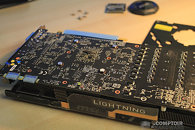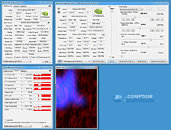- Joined
- Oct 9, 2007
- Messages
- 47,496 (7.49/day)
- Location
- Hyderabad, India
| System Name | RBMK-1000 |
|---|---|
| Processor | AMD Ryzen 7 5700G |
| Motherboard | ASUS ROG Strix B450-E Gaming |
| Cooling | DeepCool Gammax L240 V2 |
| Memory | 2x 8GB G.Skill Sniper X |
| Video Card(s) | Palit GeForce RTX 2080 SUPER GameRock |
| Storage | Western Digital Black NVMe 512GB |
| Display(s) | BenQ 1440p 60 Hz 27-inch |
| Case | Corsair Carbide 100R |
| Audio Device(s) | ASUS SupremeFX S1220A |
| Power Supply | Cooler Master MWE Gold 650W |
| Mouse | ASUS ROG Strix Impact |
| Keyboard | Gamdias Hermes E2 |
| Software | Windows 11 Pro |
Ahead of its launch, French tech publication Le Comptoir du Hardware scored an early sample, and wasted no time in taking high-res pictures of the card, its innards, and putting it through a battery of benchmarks. Their first opinion? That EVGA's GTX 780 Ti Classified K|ngp|n has met its match. Taller than most graphics cards, and thicker than two slots, MSI GTX 780 Ti Lightning is based on the same new-generation TriFrozr cooling solution as the GTX 780 Lightning. Its underlying PCB is unchanged, too. The card draws power from a pair of 8-pin PCIe power connectors, and conditions it using a gargantuan 20-phase VRM. The VRM uses two separate controllers for GPU and memory+PLL. The GPU and memory both draw power from the power connectors, while only the PLL draws power from the slot. This way, memory OC isn't held back by the PCIe slot power supply.
The PCB also features consolidated voltage measurement points, independent fan headers for each of the cooler's three fans (letting you control individual fan-speeds), and dual-BIOS. The cooling solution is features multiple aluminium fin stacks that draw heat from a large nickel-plated copper base, using seven 8 mm-thick heat pipes; which are ventilated by a trio of fans. MSI claims that the cooler is capable of handling thermal loads of up to 550W. The "Lightning" logo on the cooler's top lights up to the thermal load the cooler is handling. It's white up to 150W, gets brighter between 150W and 210W, and goes red beyond 210W.





The card ships with out of the box clock speeds of 993 MHz core, 1059 MHz GPU Boost, and 7.00 GHz memory. The reviewer was able to overclock that up to a staggering 1248 MHz core, and 1314 MHz GPU Boost, while leaving the memory untouched; and the memory in a separate attempt up to 8.00 GHz, while leaving the GPU untouched. The card was tested on a system with Core i7-4960X, 16 GB of quad-channel DDR3-2500 MHz memory, and an MSI Big Bang XPower II motherboard. It achieved 3DMark 11 (performance preset) score of P17872 single-handedly.



View at TechPowerUp Main Site
The PCB also features consolidated voltage measurement points, independent fan headers for each of the cooler's three fans (letting you control individual fan-speeds), and dual-BIOS. The cooling solution is features multiple aluminium fin stacks that draw heat from a large nickel-plated copper base, using seven 8 mm-thick heat pipes; which are ventilated by a trio of fans. MSI claims that the cooler is capable of handling thermal loads of up to 550W. The "Lightning" logo on the cooler's top lights up to the thermal load the cooler is handling. It's white up to 150W, gets brighter between 150W and 210W, and goes red beyond 210W.





The card ships with out of the box clock speeds of 993 MHz core, 1059 MHz GPU Boost, and 7.00 GHz memory. The reviewer was able to overclock that up to a staggering 1248 MHz core, and 1314 MHz GPU Boost, while leaving the memory untouched; and the memory in a separate attempt up to 8.00 GHz, while leaving the GPU untouched. The card was tested on a system with Core i7-4960X, 16 GB of quad-channel DDR3-2500 MHz memory, and an MSI Big Bang XPower II motherboard. It achieved 3DMark 11 (performance preset) score of P17872 single-handedly.



View at TechPowerUp Main Site






